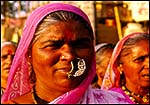

|
|
|
|
| HOME | TRAVEL | TRAVELOG | |||
 Gateway to History ... Aurangabad has some of India's finest monuments
Sanjay Singh Badnor
The next day saw me set out for the Ellora caves. But first I take a small detour to Panchaki - the amazing 17th century water mill, designed by Malik Ambar to generate energy before heading for the most . The water, brought down from a spring on a nearby mountain, is used to turn the large grinding stones which serve as a flour mill. Panchaki, a beautiful example of the water distribution system built in 1695.
And then on to Ellora. Located less than a kilometre away from the Ghrishneshwar temple, Ellora has some of the finest examples of cave-temples which represent the three faiths - Hinduism, Buddhism and Jainism. Known across the world as the Ellora Caves,they were carved into a hillside between 350 AD and 700 AD. The 34 caves occupy a two kilometere long stretch and have ornamented facades with intricate interiors. It is interesting to note that, though the caves are not arranged chronologically, the various religious groups do not overlap.
The 30 caves, located about 100 km from Aurangabad, nestle in an inner fold of the Sahyadri hills in the shape of a horseshoe. Discovered in 1819 by a group of British army officers, these caves took about 600 years to create and were once the retreat of Buddhist monastic orders featuring several chaityas or chapels and viharas or monasteries. The exquisite wall and ceiling paintings, panels and sculptures depicting the life and times of Buddha are famous throughout the world as the earliest and finest examples of Buddhist pictorial art. The Ajanta caves tell the story of a rich and a glorious past from 200 BC to 650 AD. These 30 caves were built to offer seclusion to the Buddhist monks who lived, taught and performed rituals in the chaityas and viharas, which were the seats of learning and cultural movement. Inspired by faith and devotion, each figure has been carved by the monks using only a hammer and a chisel. Ajanta offers a rich tapestry of images that speak of places, royalty, culture and stories of everyday life in ancient India. Many of the Ajanta caves hold panels that illustrate stories from the Jatakas -- a large repertoire of tales about the various incarnations of Buddha.
The caves, though set deep in the hills, still illuminate with the aid of natural light during a certain part of the day. After descending from the caves, I decide to browse through the several clusters of tiny shops which display the same wares -- stone or quartz in different hues, shapes and sizes. Uncut ameythests, rose quartz and crystal quartz were being sold for a good bargain. Had I not been travelling by air, I would have actually picked up a sackload. Photographs by Sanjay Singh Badnor
|
||
|
||
|
HOME |
NEWS |
BUSINESS |
CRICKET |
MOVIES |
CHAT
INFOTECH | TRAVEL | LIFE/STYLE | FREEDOM | FEEDBACK |
||